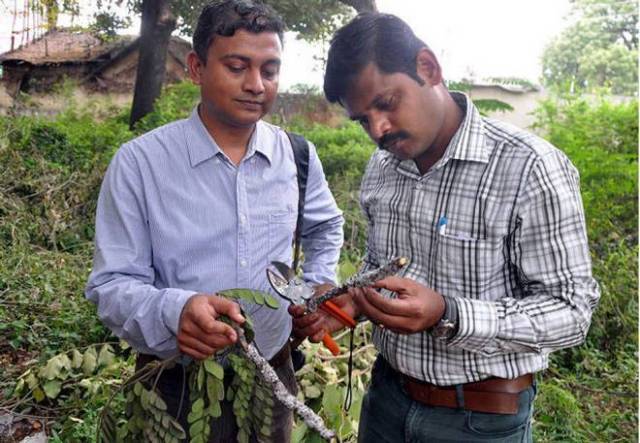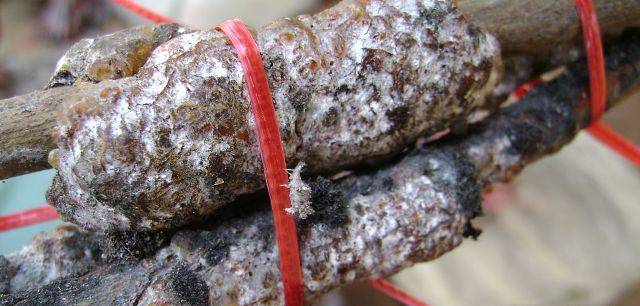
Lac cultivation is a source of livelihood for the villagers at their doorstep. Interestingly, the State of Chhattisgarh is encouraging lac cultivation through different schemes to provide additional income. The Shellac is the processed product and greatly used in confectionary, food products, pharmaceuticals, cosmetics, paints and varnishes etc.
What are the stages involved in lac cultivation?
There are four main stages involved in lac cultivation:
Stage 1: Inoculation
Stage 2: Swarming
Stage 3: Phunki Removal
Stage 4: Harvesting of Lac
1. Inoculation:
The first stage of lac cultivation is Inoculation. It is the process by which newly hatched (brood) nymphs get associated with new branches of host plants.
It takes place in two ways:
A. Natural/Self-/Auto- inoculation:
It takes place naturally and routinely. Here, the swarmed nymphs of one plant infect the same host again and start to inhabit (encrust) on it. But, the inoculation process is discouraged for some reasons.
Drawbacks of Natural Inoculation:
-
Nutrition Deficiency
-
Non-Uniform Inoculation
-
Adverse Climate
-
Parasites and Predators

B. Artificial Inoculation:
These days artificial inoculation is being practised. The main idea behind it is to overcome the drawbacks of natural system. Once the brood lac has been cut from the plants, it is necessary to subject it to proper examination, so only healthy lac with minimum signs of predator and parasite damage is selected to be used as brood lac. It is important to minimize the chances of propagation of the lac insect enemies.
Precautions to be taken during Artificial Inoculation:
-
One should be very careful during this process. Only the fully mature and healthy brood twigs, free from pest infestation and disease must be taken.
-
Brood twig or seed twig for inoculation must be used immediately after crop cutting and it should not be kept for a long time.
-
For preventing falling of seed twig, tie the seed twig very securely on the upper surface of branches. It will not only ensure full contact for quick but also easy crawling of nymphs from seed twigs to host twigs.
-
Generally, 3-4 seed twigs must be tied at one place of host twig for better inoculation.
-
However, if the brood twig is taken from a particular host plant year after year, it can deteriorate the quality of lac production. Hence, alteration of both brood and host is preferred for proper nutrition and good quality of lac and nymphs.
-
Humid weather can prevent swarming of nymph from brood. So, room-stored seed lac twigs can be heated to 200°C to induce swarming before tying.
-
It must be noted that cultivation of Kusmiin place of Rangeeni and vice versa should be avoided.
Time of Inoculation:
Each strain of lac insect (Rangeeni and Kusmi) yields two crops a year: Kartiki and Baisakhi in case of Rangeeni, and Jethai and Aghani in case of Kusmi. Hence, the inoculation time of different strains varies. For Kartiki June/July; for Baisakhi October/November; for Aghani July and for Jethai is January/February.
2. Swarming:
It is the most crucial stage of lac cultivation. The colour change of the eggs tells the time of swarming. One should note that, at the time of hatching, the eggs become orange coloured. Following swarming of nymphs, the hollow cavities left in the cell get covered with- wax. So, it is an indication that swarming has taken place.
3. Phunki Removal:
It is the process of removal of brood lac twigs which are used for inoculation purposes. The used up brood lac after complete emergence of lac nymphs from female cells is defined as phunki removal. Ordinarily, the emergence of lac nymphs from the brood lac ceases after three weeks.
Then, phunki lac is scrapped off from the brood lac to avoid emergence of enemy insects. These phunki bundles are pulled down from the host trees with the support of pole mounted phunki hook or by climbing on trees.
4. Harvesting of Lac:
Harvesting is defined as the process of collection of lac from the host trees. This process is done by cutting the lac encrusted twigs when it is matured. Harvesting process can be done in two ways:
A. Immature Harvesting:
Here, the lac is collected before swarming. Lac, which is obtained, is called ‘ARILAC’. The lac insect may be damaged at the time of immature harvesting that would cause population destruction of lac insects and can result in great economic loss to cultivators. But, in case of Palas lac (Rangeeni lac), this type of lac was found to give better quality of production. So, only for this lac immature harvesting is encouraged.
B. Mature Harvesting:
In this process, lac is collected after swarming. The lac which is obtained is called ‘Mature Lac’. It is very important to know the exact date of emergence and swarming of nymphs for mature lac harvesting. A simple visual method is adopted for this purpose. However, a yellow spot develops on the posterior side of the female lac cell toward crop maturity.
Then, the spots spread forward until it covers half of the cell. Cutting of twigs for harvesting can be done at any time between the stages. But, the yellow spot occupies one-third to one-half of the cell area. Though, at times it is desirable to wait till the emergence of first new nymphs.
Harvesting Time:
It should be noted that with different inoculation time, harvesting time for different crops also varies. On one hand, the Kartiki crop is harvested in October/November, Baisakhi in May/June; Aghani in January /February and Jethwi in June/July.
Profitable Tips recommended for harvesting:
-
Only mature crops must be harvested. Immature/arilaccutting should be strictly avoided except in Palas lac.
-
A moderate crop is said to be the one from which nymph will take place in 7-10 days. Hence, the crop should be harvested within the above time period before nymphal
-
If self-inoculation is not required, then the entire crop may be reaped. For Rangeenicrop, only the lac encrusted twigs are cut. However, in case of Kusum crop, reaping should be accompanied with pruning.
-
The brood sticks harvested, must be utilisedfor inoculation as soon as possible. If required, storage should be done in shaded, well ventilated room.
-
Harvesting of lac crop at maturity can prevent the crisis of brood lac to a great extent without affecting the quality of lac which is obtained as stick lac.
















